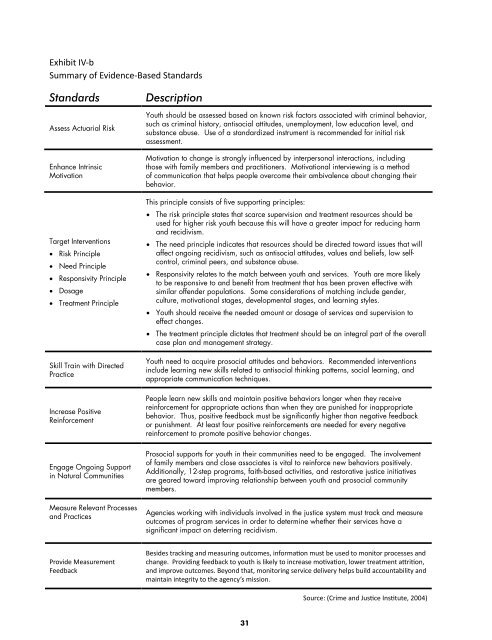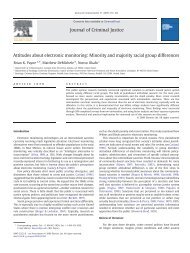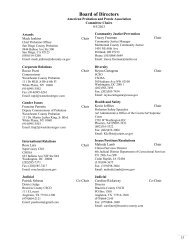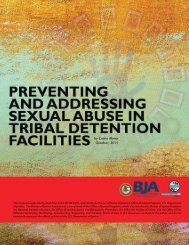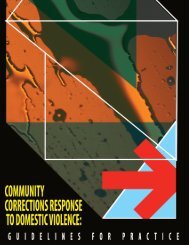Intervention Principles and Practice Guidelines for - Underage ...
Intervention Principles and Practice Guidelines for - Underage ...
Intervention Principles and Practice Guidelines for - Underage ...
Create successful ePaper yourself
Turn your PDF publications into a flip-book with our unique Google optimized e-Paper software.
Exhibit IV-b<br />
Summary of Evidence-Based St<strong>and</strong>ards<br />
St<strong>and</strong>ards<br />
Assess Actuarial Risk<br />
Enhance Intrinsic<br />
Motivation<br />
Target <strong>Intervention</strong>s<br />
• Risk Principle<br />
• Need Principle<br />
• Responsivity Principle<br />
• Dosage<br />
• Treatment Principle<br />
Skill Train with Directed<br />
<strong>Practice</strong><br />
Increase Positive<br />
Rein<strong>for</strong>cement<br />
Description<br />
Youth should be assessed based on known risk factors associated with criminal behavior,<br />
such as criminal history, antisocial attitudes, unemployment, low education level, <strong>and</strong><br />
substance abuse. Use of a st<strong>and</strong>ardized instrument is recommended <strong>for</strong> initial risk<br />
assessment.<br />
Motivation to change is strongly influenced by interpersonal interactions, including<br />
those with family members <strong>and</strong> practitioners. Motivational interviewing is a method<br />
of communication that helps people overcome their ambivalence about changing their<br />
behavior.<br />
This principle consists of five supporting principles:<br />
• The risk principle states that scarce supervision <strong>and</strong> treatment resources should be<br />
used <strong>for</strong> higher risk youth because this will have a greater impact <strong>for</strong> reducing harm<br />
<strong>and</strong> recidivism.<br />
• The need principle indicates that resources should be directed toward issues that will<br />
affect ongoing recidivism, such as antisocial attitudes, values <strong>and</strong> beliefs, low selfcontrol,<br />
criminal peers, <strong>and</strong> substance abuse.<br />
• Responsivity relates to the match between youth <strong>and</strong> services. Youth are more likely<br />
to be responsive to <strong>and</strong> benefit from treatment that has been proven effective with<br />
similar offender populations. Some considerations of matching include gender,<br />
culture, motivational stages, developmental stages, <strong>and</strong> learning styles.<br />
• Youth should receive the needed amount or dosage of services <strong>and</strong> supervision to<br />
effect changes.<br />
• The treatment principle dictates that treatment should be an integral part of the overall<br />
case plan <strong>and</strong> management strategy.<br />
Youth need to acquire prosocial attitudes <strong>and</strong> behaviors. Recommended interventions<br />
include learning new skills related to antisocial thinking patterns, social learning, <strong>and</strong><br />
appropriate communication techniques.<br />
People learn new skills <strong>and</strong> maintain positive behaviors longer when they receive<br />
rein<strong>for</strong>cement <strong>for</strong> appropriate actions than when they are punished <strong>for</strong> inappropriate<br />
behavior. Thus, positive feedback must be significantly higher than negative feedback<br />
or punishment. At least four positive rein<strong>for</strong>cements are needed <strong>for</strong> every negative<br />
rein<strong>for</strong>cement to promote positive behavior changes.<br />
Engage Ongoing Support<br />
in Natural Communities<br />
Measure Relevant Processes<br />
<strong>and</strong> <strong>Practice</strong>s<br />
Prosocial supports <strong>for</strong> youth in their communities need to be engaged. The involvement<br />
of family members <strong>and</strong> close associates is vital to rein<strong>for</strong>ce new behaviors positively.<br />
Additionally, 12-step programs, faith-based activities, <strong>and</strong> restorative justice initiatives<br />
are geared toward improving relationship between youth <strong>and</strong> prosocial community<br />
members.<br />
Agencies working with individuals involved in the justice system must track <strong>and</strong> measure<br />
outcomes of program services in order to determine whether their services have a<br />
significant impact on deterring recidivism.<br />
Provide Measurement<br />
Feedback<br />
Besides tracking <strong>and</strong> measuring outcomes, in<strong>for</strong>mation must be used to monitor processes <strong>and</strong><br />
change. Providing feedback to youth is likely to increase motivation, lower treatment attrition,<br />
<strong>and</strong> improve outcomes. Beyond that, monitoring service delivery helps build accountability <strong>and</strong><br />
maintain integrity to the agency’s mission.<br />
Source: (Crime <strong>and</strong> Justice Institute, 2004)<br />
31


